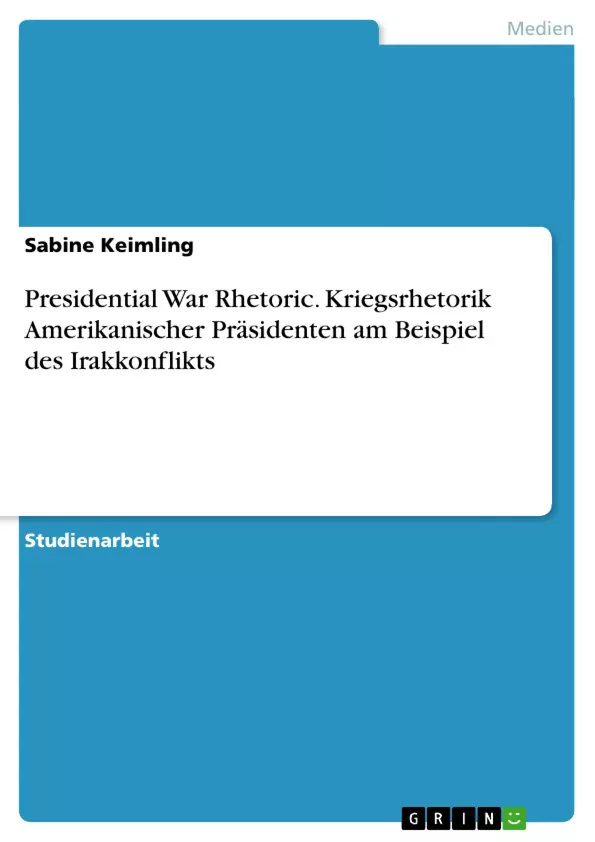Politics is connected with power. The acquisition of power, and the enforcement of a political belief can be achieved in a number of ways. One of the most obvious methods is through physical coercion. Under despotic and military regimes (for instance the dictatorship of Adolf Hitler), those in power often control people by using force. But also democracies can utilize language as a force to manipulate, influence and control people. In this assignment I will illustrate how language is employed to achieve political aims; particularly I will show how even nowadays politicians adopt original Greek rules of speech to increase the impact of their ideas and to persuade their audience of the validity of the politician’s basic claims. Rhetoric is the “ancient skill of elegant and persuasive speaking” or the “art of persuasive discourse”. And persuasion “is an art, primarily verbal, by which you get somebody to do what you want and make him at the same time, think that this is what he wanted to do all the time”. The Greek philosopher Plato and Socrates believed rhetoric is the “mother of lies… distorts and conceals the truth” and people who are insincere in their motives manipulate their audience.
To examine the war rhetoric throughout U.S. history I will use three speeches of George H. Bush (“While The World Waited”, 1991), Bill Clinton (“Radio Address Of The President To The Nation”, 1998) and the ultimatum speech of George W. Bush (“President Says Saddam Hussein Must Leave Iraq Within 48 Hours”, 2003), which opened the attack against the Iraq. All of the speeches are characterized through the long traditional presidential war rhetoric of America. They realize their aims and objectives through rhetorical argumentations and linguistic persuasive devices that are similar in all three speeches. In the first part of this assignment I will show how the presidents clarify reasons and define purposes of war, explain and justify their sanctions and create a “friend and foe image”. Subsequently I will have a closer look to rhetorical figures and linguistic strategies that are employed by the presidents.
Inhaltsverzeichnis
- Introduction
- Legitimisation of a war
- Aims to improve the social and political situation in Iraq
- Establishment of "friend- and foe-images"
- Rhetorical devices
- Pronouns
- Syntax
- Concise language structures
- Colloquial language
- Superlative forms and boosting devices
- Intransitive verbs
- Linguistic figures
- Introduction
- Anaphora
- Anadiplosis
- Tautology
- Polysyndeton
- Climax
- Hendiadys
- Alliteration
- Asyndeton
- Pleonasm
- "Three-part-list"
- Contrastive pair
- Euphemism
- Metaphor
- Personification, Metonymy and Synecdoche
Zielsetzung und Themenschwerpunkte
Diese Arbeit analysiert die Rhetorik amerikanischer Präsidenten während Kriegszeiten am Beispiel des Irakkonflikts. Sie untersucht, wie Sprache eingesetzt wird, um politische Ziele zu erreichen, insbesondere wie Politiker klassische rhetorische Mittel nutzen, um die Wirksamkeit ihrer Botschaften zu verstärken und ihr Publikum von der Gültigkeit ihrer Behauptungen zu überzeugen.
- Die Legitimierung von Krieg durch die Präsidenten
- Die Konstruktion von Freund- und Feindbildern
- Die Analyse rhetorischer Mittel und linguistischer Strategien
- Die Bedeutung von Sprachgebrauch in der politischen Macht
- Die Analyse der drei Präsidentenreden im Kontext der amerikanischen Kriegsrhetorik
Zusammenfassung der Kapitel
Die Arbeit beginnt mit einer Einführung in das Thema der Kriegsrhetorik und der Bedeutung von Sprache in der Politik. Sie analysiert dann die Strategien der Präsidenten, um den Krieg im Irak zu legitimieren, einschließlich der Darstellung der Ziele des Krieges, der Verbesserung der sozialen und politischen Situation im Irak und der Etablierung von Freund- und Feindbildern. Die Arbeit untersucht auch eine Reihe rhetorischer Mittel, die von den Präsidenten verwendet werden, um ihre Botschaften zu verstärken, wie z. B. Pronomen, Syntax und verschiedene sprachliche Figuren.
Schlüsselwörter
Kriegsrhetorik, amerikanische Präsidenten, Irakkonflikt, Legitimierung, Rhetorische Mittel, Freund- und Feindbilder, Propaganda, Persuasion, Sprachgebrauch, Politik.
- Citation du texte
- Sabine Keimling (Auteur), 2004, Presidential War Rhetoric. Kriegsrhetorik Amerikanischer Präsidenten am Beispiel des Irakkonflikts, Munich, GRIN Verlag, https://www.grin.com/document/25495



